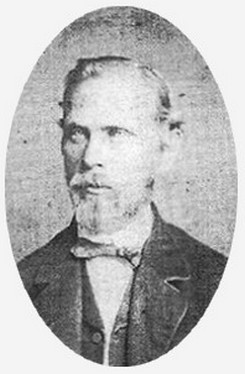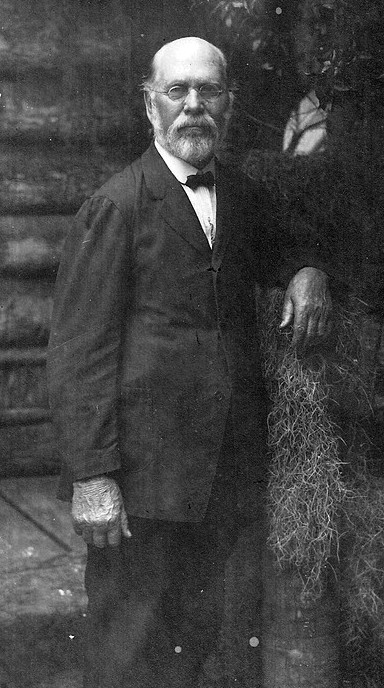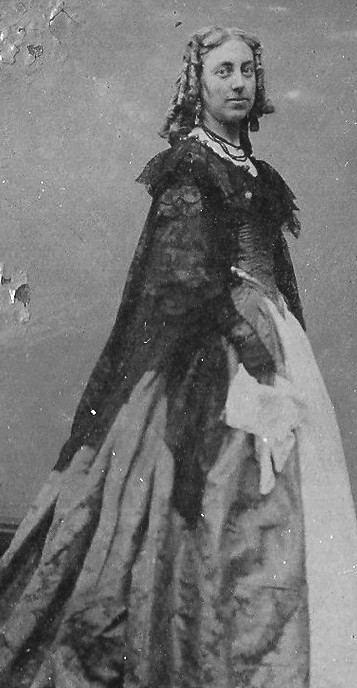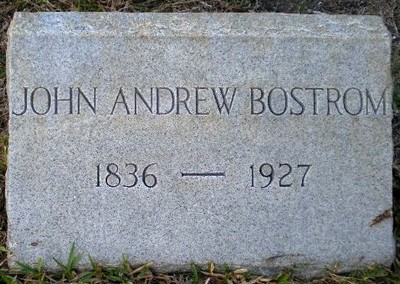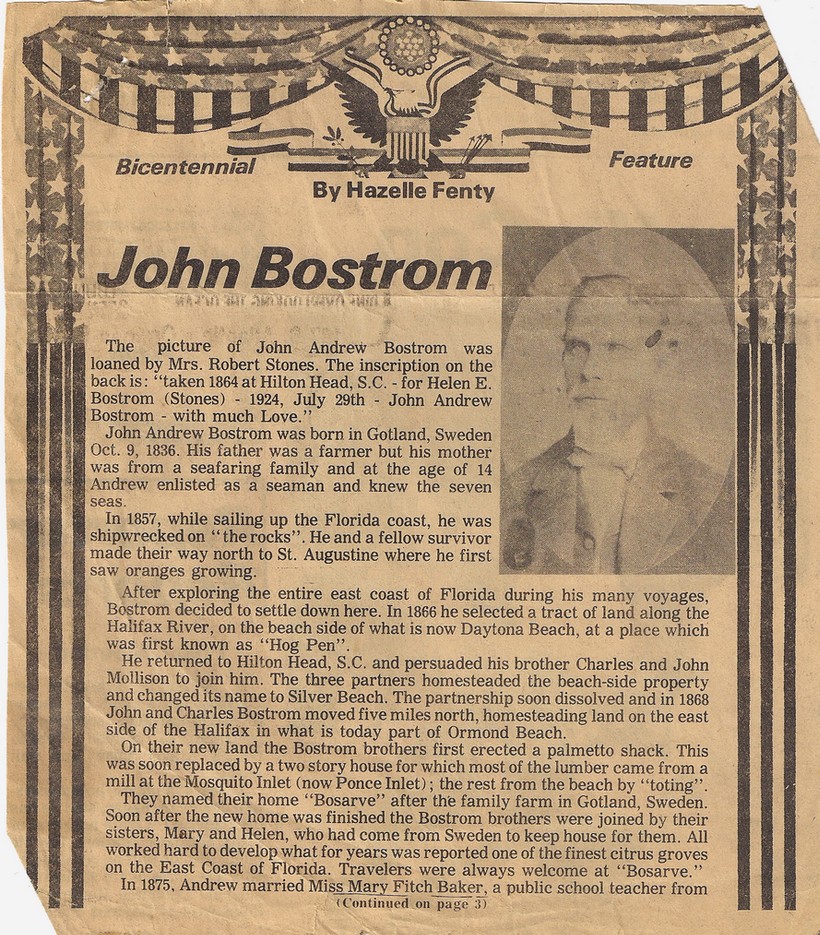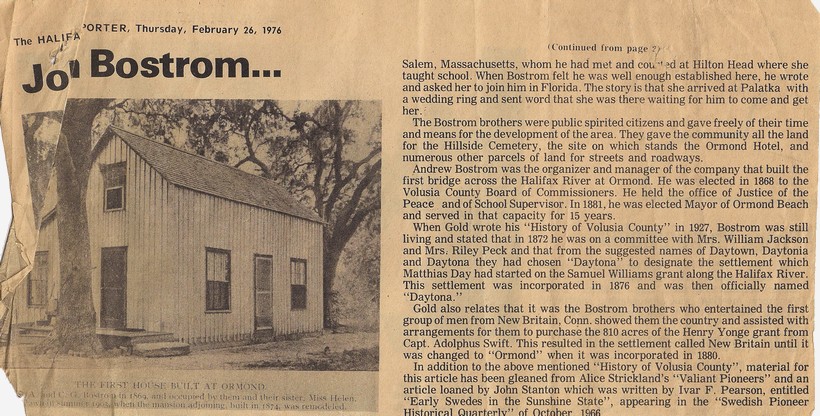|
Johannes Boström |
|||||||
|
|
||||||
|
|
|
||||||
|
|
|||||||
|
|||||||
|
|
|||||||
|
|
|||||||
|
|
|||||||
|
Gravsten på Hillside Cemetery |
|||||||
|
|
|||||||
|
|
|||||||
|
En gotländsk nybyggare om Florida. (Stockholmsbref till Gotlands Allehanda.) Å utställningen träffade jag häromdagen en bekant svensk redaktör. Han hade i sällskap en äldre man, satt till växten, och som gaf intryck af hvad man kallar en sjöbjörn. −Får jag lof att presentera m:r J. A. Boström, mayor (borgmästare) i Ormond, staten Florida, den sydligaste i Förenta Staterna, sade han. Född på Gotland, började han sin bana som skeppsgosse och slutar som mayor, så vida han inte blir president där borta i Washington! −Well, sade mr B., jag har sett i tidningarna, att ni träffade samman med min vän Jobsson från New-York, och på grund däraf skrifvit ett och annat om de norra staterna. Men säg något om ”den blomrika” (Florida) staten också. Ni känner Florida? Javisst kände jag ett och annat, genom böcker n . b. Där rasade spanjorer nu för något mer än 200 år sedan nästan värre än i Sydamerika; de ha ännu minnen kvar: ruiner af borgar och ödelagda land. Kom så i banden på England och gick sist i Förenta staternas förbund. −Hvad gaf er anledning att begifva er så långt åt söder, som till Florida? frågade jag. −Ja, det kan jag tala o m. jag var son sjöman med i slafkriget på nordstaternas sida, såg till och med på kort afstånd, när Monitor sammandrabbade med Merrimac. (1*) Nå kriget tog slut, och jag behöfde hvila mig lite. ”Gick” så ner till Florida för att värmas af sol och supa hafsluft på samma gång. Tog in i Ormond därnere vid nordöstra kusten. Vaknade en morgon – det var annars i Februari – och tittade ut genom fönstret. Därute var en trädgård och där hängde i träden apelsiner mogna, ”Well” sade jag till mig själf, ”här är mig godt att vara, här stannar jag kvar”. Och jag stannade. Där var nog svårigheter att börja med, ty en vanlig sjöman har ju intet kapital. Men naturens herre hjälpte mig, tack vare den präktiga natur han där danat. Jag började att slå mig på först och främst mina vänner apelsinerna och så – i ännu vidare omfattning – ”pineäplen” (2*), persikor och citroner. ”Kennst du das Land, wo die Citroner blüb’n”, tänkte jag med den store Göthe. −Och så smultron, tillade han; Florida är ett verkligt smultronparadis. −Plocka ni ”smultron under snön” ? frågade jag skämtande. −Snön? svarade han. Vi ha ingen snö, ingen vinter. Smultron plocka vi och sälja i December och Januari. Så kommer persikorna, pinäplena, citronerna och apelsinerna och en mängd andra fruktslag månad efter månad. Vi ha ej en skörd blott, nej fem à sex. Men här vill jag tillägga, att visserligen är vår jord nästan jungfrulig – jämförelsevis litet gödsel är af nöden – men tålamod och ihärdigt arbete får man använda. Ogräs och skadliga insekter måste man mörda, energiskt mörda. Men så försvinner de till sist. −Klimatet där nere, så nära tropikerna, är väl ändock fördömdt hett? −Visserligen hett stundom. Men vi har ju våra svala vindar från Atlanterhafvet och Mexikanska viken; det är dessa, som fläkta så sundt, och mildra temperaturen. Solstygn känna vi ej till; annars en mycket vanlig händelse däruppe i norr, i New-York, ja, till och med i Chicago under de varmaste månaderna. Florida har det behagligaste klimatet i världen. −Detta är dock något öfverdrifvet −Betrakta mig, genmälde förre sjöbussen, ser jag ut, som om jag har haft malaria, hvilket man beskyller Florida för. Jag har fylt sextioett år, men är stark som två nordiska björnar tillsamman. Och härmed höjde han – i äkta Yankee-stil – sin väldiga högre näfve och knep samman mina skrifvarfingrar. De sutto som i skrufstäd. −Jag har varit på amerikanska fartyg, sade han, och där fingo de erfara, att ”mandom mod och morske män finns i gamla Sverige än” – när så var af nöden. Annars är jag den fredligaste människa under solen. Men jag är tidningsskrifvare, jag också, tillade han leende. −Under signaturen Auka-Thor? −Men till fakta, om er så behagar, fortsatte han; jag bor i Ormond, som nämndt blifvit. Men hela staten känner jag till punkt och pricka, efter att ha varit där i trettiotvå år. I vår stat odlas hafre, hvete, sockerrör, tobak, risgryn och allehanda grönsaker och gräsörter, fruktträden har jag redan talat om. Och så ha vi den fördelen, att vi kunnat afyttra våra produkter, när de andra staterna, i följd af de klimatiska förhållandena, måste vara köpare. Florida är Förenta staternas naturliga drifhus. Vi sälja våra produkter till marknaderna i New-York, Brooklyn, Filadelfia, Boston och Chicago under vintermånaderna, då termometern på dessa ställen sänker sig 10 à 30 grader under fryspunkten. Källan till landets rika fruktbarhet är dess solsken. Under årets lopp förekommer omkring 240 solskensdagar med klar himmel. Det var sant, vi har fyra sorter vindrufvor; de skördas och utskeppas i Juni. Nog ha vi rikedom på naturliga hjälpkällor, både till lands och vatten. Detta erinrar mig, att vi uppföder hornboskap, får, getter, svin och fjäderfän, samt 120 sorters fisk finnas vid Floridakusten. Och nu har jag talat åtskilligt om mitt och antal andra svenskars andra fädernesland, och tillägger blott, att en stor del af landet ännu ligger ouppodlat, samt afslutar med ett uttalande af vår president W. Mc Kinley: ”Florida har en stor framtid för sig. Mera kändt, kommer det att bli hemvid för en talrik, välbärgad befolkning, och landets tillgångar äro nästan obegränsade. (Källa: 1079)
------------------------------------
(1*) I U.S.A:s tjänst hette hon USS Merrimac. I C.S.A:s tjänst hette hon CSS Virginia. (2*) Ananas |
|||||||
|
|
|||||||
|
|
|||||||
|
|
|||||||
|
|
|||||||
|
|
|||||||
|
|
|||||||
|
|
|||||||
|
|
|||||||
|
BOSTROM, JOHN ANDREW, of Ormond Beach, is probably the oldest settler still living on the coast of Florida. In a brief biography it is not possible to recount and in fact little more than suggest his great range of experiences extending back to Civil war times in Florida. From early youth he was familiar with the sea and the sea was practically the only approach to Florida until within comparatively recent years. He was born on the Island of Gottland in the Baltic Sea, a Swedish subject, October 9, 1836, son of LARS and ANNA JOHANNA (VEDIN) BOSTROM. His father was a farmer and supervisor of religious affairs on the Island of Gottland. The VEDIN family were sea faring people. JOHN ANDREW was the fifth in a family of twelve children, nine of whom reached mature years, and he and his brother CHARLES have for many year been closely associated and live on adjoining places in Florida, and they have a sister living at De Land. JOHN A. BOSTROM attended school in his home community until he was fourteen, and has been a student of books and experience ever since. He was employed as clerk in a country store until he was twenty, when, to satisfy a longing for foreign lands, he embarked as a sailor, his first voyage carrying him to the British Isles and the Mediterranean Sea. Later he went to China, and in 1859 sailed from China to New York. For two years he was on vessels engaged in the coasting trade along the Eastern States. After a brief visit to his old home in Sweden he again returned to America. The first trip that brought him to Jacksonville was in 1860. Then, in 1861, he was at the Barbados and other West India Islands. Strongly opposed to slavery, he entered the Union service in the navy as quartermaster on a transport, with headquarters at Hilton Head in South Carolina. Soon afterward he was shipwrecked on St. Johns Bar near Jacksonville. That was the third shipwreck in his experience. The first occurred in the China Sea and the second in the Gulf Stream. The third adventure decided him to live on land. During the closing months of the Civil war he was a merchant at Hilton Head. Mr. BOSTROM had seen oranges ripen in February on the Coast of Florida, and he determined to come to this land of sunshine and semi-tropical climate. At Hilton Head he bought a Government launch, using army tents for sails, and in this boat came down the coast to St. Augustine. He left his boat there and then proceeded down the coast to Mosquito Inlet, and with the help of a colored man, ISRAEL McKINNEY, carried a small boat overland to the bank of Halifax River. He went down this stream exploring and the only sign of white settlements on the way were at Fort Orange and New Smyrna. He then went back to St. Augustine, where there was one little hotel, secured his own boat and sailed down the coast and up the Halifax River. He named the boat Anna in honor of his mother. It was in 1866 that Mr. BOSTROM first settled on land now included in the City of Daytona. In 1868 he homesteaded a ninety acre strip of land extending from the river to the ocean, and on this land he still has his home. His brother CHARLES homesteaded adjoining land on the north. It is on a portion of this tract that the Ormond Hotel was afterwards built, and also the winter homes of Judge Shiras and of John D. Rockefeller. The first home of Mr. BOSTROM was built of palmettos. Later a sawmill was established by Doctor Hawkes, who had come from New Hampshire and organized the Florida Land and Lumber Company. This mill was built near Mosquito Inlet. In 1868 Mr. BOSTROM secured lumber from this mill to erect a two story frame residence. To the original building Mr. BOSTROM added in 1902, and now has a home in keeping with those of the community, and has his grounds adorned with fruits and flowers, and for many years has grown oranges and grape fruit. Mr. BOSTROM in 1875 married Miss MARY BAKER, who was born in Salem, Massachusetts, in 1838. She died in 1903. There were two children, LARS EDWARD and HELEN ESTHER. The daughter married JAMES P. STANTON, and is now deceased, leaving a daughter, EDITH MAY, wife of J.F. PAFFE, representing one of the old Spanish families of Florida. As one of the original settlers Mr. BOSTROM has witnessed every phase of development in and around Ormond, and when the town was built and organized he became a member of the council and for fifteen years or more served as mayor. For two years by appointment he was county commissioner and also school supervisor. He organized The Bridge Company and became its manager, and also assisted in organizing the company that built the Coquino Hotel, now known as Bretton Inn at Ormond Beach. Mr. BOSTROM was either president or secretary of the hotel company until recently. All the older settlers sought out Mr. BOSTROM for advice when they came here, and he has been an intimate friend of many of the prominent people in this section of Florida. His son LARS has always had a strong liking for machinery. The father and son some years ago established a feed store at Ormond Station, and late they built an ice plant and to that subsequently added a light and power plant. Mr. BOSTROM is a Unitarian in religious belief. |
|||||||
|
|
|||||||
|
|
|||||||
|
EARLY SWEDES IN THE SUNSHINE STATE IVAR F . PEARSON JOHN ANDREW BOSTROM First settler of Ormond Beach, Florida, and in all probability the first Swede to settle in the Sunshine State. John Andrew Bostrom was born in Gotland, Sweden, October 9,1836, the fifth child in a family of twelve children. His father was Lars and his mother was Anna Johanna (Vedin) Bostrom. His father was a farmer, but the Vedins were seafaring people, and at the age of fourteen Andrew enlisted as a seaman and knew the seven seas. After coming to New York he followed the coastal trade. In 1857, while sailing up the Florida coast, he was shipwrecked on "The Rocks," a rocky coastal area. He and a fellow survivor made their way north overland to St. Augustine where he first saw oranges growing. He was impressed with the sight of both bloom and fruit on the trees at once. He made several exploratory trips along the coast between Jacksonville and Biscayne Bay. He noted a narrow sandy strip along the ocean and thought it would never be worth anything—now Miami Beach! He stayed in the Jacksonville area until the war broke out, enlisted in the Service and served as Captain on a blockade runner stationed at Hilton Head, South Carolina. At the close of the war, as part of his mustering-out pay, he bought from the Navy certain surplus goods and a yawl. Decking it over and fitting it with a mast, he made a sail from an old army tent and set out in search of a place to homestead. After a stop at St. Augustine, the rest of the 191 journey is described by Mr. Bostrom in a letter to his friend, John Anderson. It reads: "In St. Augustine I hired a small boat and laid in a month's provisions. I found a pilot by the name of Israel who had been working as a slave on plantations where Ormond and Daytona are now located. "We sailed down the Mantanzas River to St. Joseph's plantation where at that time lived a man named Joe who had a wagon and an ox team. We loaded the boat onto the wagon, put our accoutrements into it and started for Bulow Landing at the headwaters of the Halifax River, a distance of sixteen miles. Took us two days, including loading and unloading. We made an appointment with Joe to meet us again in thirty days and started southward. "I expect we saw as many as fifty alligators on the way down to the so called basin where the Tomoka River enters the Halifax. At the basin there was a bitter sweet grove which I bought and later sold to Joe Bryan, a former citizen of Daytona. It is called Tiger Grove to this day. "We came at last to the Sam Williams and Herrot plantation on which Daytona is now located. We camped on the east side where the water was deep and the fishing good. We settled here, and three months later called it Silver Beach which name it bears to this day."1 The three months referred to represent the time it took Bostrom to return to Hilton Head, where his brother Charles now joined him, and get back to Silver Beach. This was in 1866. Two years later they moved five miles to the north and homesteaded some ninety acres each. Together the homesteads had a frontage of one mile on Halifax River and one mile on the ocean. The Halifax runs parallel with the sea a short mile inland. The land cost them two dollars per acre. It was forest primeval. There were no near neighbors. The total population of Florida at the time was approximately 165,000 with an average of three persons to the square mile. In the early days at Ormond Beach Bostrom 1 Letter dated Dec. 11, 1907 quoted in an article on Bostrom by E. N. Waldron in T h e H a l i f a x J o u r n a l. 192 used his yawl to bring in supplies and mail to the settlers along the Halifax and Indian Rivers. On their new land the Bostrom brothers first erected a palmetto shack. This was soon replaced by a two-story house for which most of the lumber came from a mill at the Mosquito Inlet; the rest from the beach by "toting." They named their home "Rosarve" after the family farm on Gotland. The house still stands on Riverside Drive in Ormond Beach with an orange grove behind it. The present owners, however, have let it go to wrack and ruin. Soon after the new home was finished the Bostrom brothers were joined by their sisters Mary and Helen who had come from Sweden to keep house for them. A l l worked hard to develop what for years was reported one of the finest citrus groves on the East Coast of Florida. In the early 1870's, Mathias Day, the founder of Daytona Beach wrote in his daily journal of a visit to Rosarve as follows: "Passed over the Halifax River to Bostroms (Swedes) and found signs of much labor and horticulture of taste. They had peas, beans and potatoes, shredded beef, honey, and a tea made from dried Bay leaves. The Misses Bostrom are unable to speak English. They got up a splendid supper with no apparent effort or disturbance. And they spread out the nicest bed I have got into in Florida. It was such a luxury that I stuck to it closely in the morning, being very tired. After breakfast we had a look at Bostrom's excellent garden, orange grove and potatoes, all in fine order for eating."2 Travelers were always welcome at Rosarve, and one of their many guests said of the Bostroms: "They have the best house and show the best evidence of industry and thrift on the River." In 1875 Bostrom married Miss Mary Fitch Baker, a public school teacher from Salem, Massachusetts, whom he had met and courted at Hilton Head where she taught school for a 2 From the Mathias Day diary quoted by Alice Strickland in T h e V a l i a n t P i o n e e r s : A H i s t o r y of O r m o n d B e a c h (1963) 193 time. After the war she returned to Massachusetts, and now that Bostrom felt well enough established to take a wife, he asked her to join him in Florida. The story is that she arrived at Palatka with a wedding ring and sent word that she was there waiting for him to come and get her. Andrew Bostrom made a large place for himself among "The Valiant Pioneers" of his time. (See Sources of Data, 4) He was a man of superior qualities, highly intelligent, industrious and enterprising, and withal a man of proven integrity. Physically he was a very strong man. He was known to lift a hogshead of flour to his shoulder and "tote it off." (Approximately 250 lbs.) He taught himself English by the use of a polyglot Bible. He was a close associate of Henry Flagler, Joseph Price and John Anderson, all noted among the developers of Ormond Beach; and worked closely with agriculturist Luther Burbank in the propagation and improvement of the citrus fruits. Moreover, the Bostrom brothers were public spirited citizens who gave freely of their time and means for the common weal. Andrew's business operations, in addition to orange and grapefruit growing, included the manufacture of small boats for which there was a lively demand. He also served as an immigration agent and as such he sought to get Swedish people to come to Florida. He was the organizer and manager of the company that built the first bridge across the Halifax River at Ormond Beach. In 1868 he was elected to the Volusia County Board of Commissioners. At that time the county seat was at Enterprise, and to attend board meetings there he would sail his boat to Port Orange, then walk thirty miles, crossing Spruce Creek, Deep Creek, and other streams. When the water was high he would take off his clothes and tie them atop his head to keep them dry before wading in. In 1869 and 1870 Bostrom had to make this arduous trip at least every two months. He held the office of the Justice of the Peace and of School Supervisor. In 1881 he was elected Mayor of Ormond Beach and served in that capacity for fifteen years. Contributions of the two 194 Bostroms to the growth and welfare of the community included all the land in the Hillside Cemetery, the site on which stands the Ormond Hotel, and numerous parcels of land for streets and roadways. Andrew Bostrom passed away on December 29, 1927, at the ripe age of 91 years. His wife died in 1911. They left two children, Lars and Helen, and there are nine living grandchildren. At the funeral service for Andrew Bostrom, his friend, Dr. John M . Richmond, paid him the following tribute: "He was a man of sterling qualities and for half a century had been an outstanding figure in the community in which he lived; he was honest, industrious and intelligent." Charles Bostrom married late in life and there were no children. He died March 25,1925, aged 83. Both of the Bostroms and their families were laid to rest in Hillside Cemetery, Ormond Beach.3 3 R e f e r e n c e s : H i s t o r y of V o l u s i a C o u n t y , F l o r i d a by Pleasant Daniel Gold (1927); B i o g r a p h i e s of P r o m i n e n t P e o p l e i n V o l u s i a C o u n t y by Pleasant Daniel Gold (1927); C e n t e n n i a l H i s t o r y of V o l u s i a C o u n t y, edited by Ianthe Bond Hebel (1955); Valianti P i o n e e r s : A H i s t o r y of O r m o n d B e a c h by Alice Strickland (1963). —Also personal interview with the present historian of Volusia County, Mrs. Ianthe Bond Hebel, and the use of her Bostrom notes. Valuable data were supplied by grandson, Charles Andrew Bostrom of Chicago, 111., who also checked the manuscript for accuracy; and by John F. Stanton of Ormond Beach. |
|||||||
|
|
|||||||
